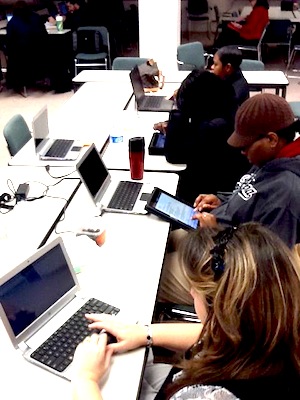
fno.org
|
|
| Vol 22|No 3|January/February 2013 | |
| Please feel free to e-mail this article to a friend, a principal, a parent, a colleague, a teacher librarian, a college professor, a poet, a magician, a vendor, an artist, a juggler, a student, a news reporter or to anyone else you think might enjoy it. | ||
The lack of examples is troubling. "Show us what you want! Show us what it looks like!" Will Macbeth read better digitally? Is digital Shakespeare better than the old one? Would the Bard take kindly to Kindle? When does it make sense to engage students in digital experiences? There should be some benefit — some enhancement of the learning. Digital is not automatically better. If the teacher sees value in the marginalia (comments and notes written in the margins) possible with eBooks, then digital may offer a step forward to strengthen comprehension. Note the articles, Knowtation: Reading and Thinking Between the Lines and Around the Edges and eReading - How is reading changing? If the teacher engages students in deconstructing an ad from Chevron, the video from YouTube, Chevron - Human Energy is right on target for CSS goals.
Deconstruct? It means break down an argument, an idea, an essay, an advertisement or a video into its component parts to evaluate the logic and the adequacy of the evidence provided. 1. What are the main ideas Chevron is promoting in the video above? 2. Which of these ideas are explicit (directly stated) and which are implicit (suggested by images and music). 3. What strategies does Chevron use to persuade the viewer of these ideas? 4. To what extent does Chevron provide evidence to support the claims made? 5. When does a video cross the line from marketing to propaganda? You can download a Media Deconstruction worksheet from medialiteracy.net in PDF. Click here.
|
||
|
Copyright Policy: Materials published in From Now On may be duplicated in hard copy format if unchanged in format and content for educational, nonprofit school district and university use only and may also be sent from person to person by e-mail. This copyright statement must be included. All other uses, transmissions and duplications are prohibited unless permission is granted expressly. Showing these pages remotely through frames is not permitted. |


 Staggering Stats: Cats Kill Billions of Animals a Year
Staggering Stats: Cats Kill Billions of Animals a Year